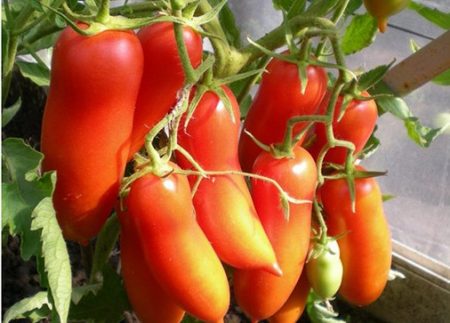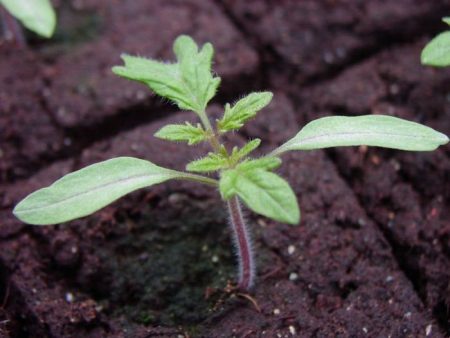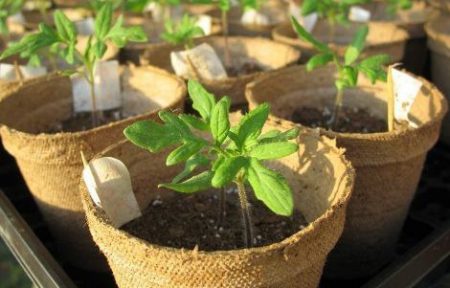 Fans of tomato diversity at their site will be interested in tomato Italian delicacy: fruitful, fruits are suitable for pickling and well stored, the care is the same as for other varieties.
Fans of tomato diversity at their site will be interested in tomato Italian delicacy: fruitful, fruits are suitable for pickling and well stored, the care is the same as for other varieties.
Content
Characterization and description of the variety
The main characteristics of the variety will tell you whether the selected material is suitable for your site, greenhouse and your requirements for the expected harvest.
Variety characteristic:
- indeterminate;
- tall (up to 200cm);
- mid-season (100-125 days);
- disease resistance is good;
- extended fruiting;
- fruitful;
- cultivation - greenhouse, open ground;
- stem formation - 2-3;
- good safety during transportation;
- feature - short internodes.
Description of the fetus:
- form - elongated cream with a pipette on the tip;
- color is red;
- weight - 100-120g;
- peel - smooth, thick, dense;
- taste - sweet-sour;
- use - fresh, canning;
- storage - storage.

Growing indeterminate tomatoes, care
The agricultural technology for growing tomatoes is different: a difference in the methods of seed treatment, planting with and without picking, a variety of options for feeding and planting seedlings.
The proposed option for tall tomatoes does not contain a dive stage and has features when planting in a greenhouse.
Seedling cultivation:
- Prepare a solution of aloe juice (keep one sheet in a bag in the refrigerator for 2-3 days) and a glass of water and hold tomato seeds in it, placing them in a bag of gauze, 1-2 hours.
- Place them in a plastic container, which they put in a bag, put in the refrigerator on the first shelf for the night, and transfer them to a room in a warm place for the daytime. Repeat the procedure three times, periodically opening the bag for air access.
- Tanks, with openings in the bottom part, of one liter volume (for example, mayonnaise buckets), fill with nutrient mixture in ½ volume, put moss on the bottom. The composition of the soil mixture should be close to that which will be in a constant place. Half-filling the volume makes it possible to sprinkle the earth with seedling growth. Plant two seeds in each bucket, put moss on top too.
- Place containers in a tray with warm water. Moss at the bottom absorbs moisture and watering seedlings is not necessary, and the top layer of moss does not allow water to evaporate.
- When the sprouts appear and get stronger, leave one - strong and strong, cut off the second.
- To feed (once) with serum, spraying the leaves.
- The temperature can withstand about 20 ° -20 °.
- With this method of growing, the roots develop powerful, strong, and the plant does not need a pick.
- If necessary, you can attach the plants to the support (pegs) and then plant with it.

Planting seedlings in a greenhouse:
- The timing of planting in the greenhouse depends on the climate of the region: mid or late May, early June.
- Seedling bushes should have 8-10 leaves, one flower brush.
Information! Seedlings of mid-season tomatoes grow, on average, 50-60 days, seeds germinate 5-6 days.
- To warm the soil in the greenhouse, you can cover it with a dark film.
- Prepare the holes in the fall, digging them up more to put layers of fertilizer:
- sand for drainage;
- moss to retain heat and moisture;
- eggshell (calcium);
- hay for heat;
- superphosphate;
- 2-3 grains of fertilizer in granules;
- cut into small pieces any vegetables to enrich potassium;
- sprinkle each layer with earth;
- the top layer is humus.
- You will get a ridge, the edges of which can be covered with mulch (grass, tops) - in the spring it will keep warm, and sow winter rye from above. Before transplanting seedlings, cut the rye where the holes were, and the rest of the rye will protect the plants at lower temperatures and from bright sunlight.
- Mix the earth in the holes, adding a spoonful of wood ash, pour warm water (one bucket per hole).
- Cover each bush with 5-liter bottles, cut the bottom, pour 1.5 liters of warm water. The lid on the neck allows you to adjust the temperature: remove when hot, and close at low temperatures.
- Lay out plastic bottles of water (2 l) on the bed around the holes, which retain heat, warming in the sun during the day.
- Cover the bed with covering material (the bottles will keep it at a certain height, protecting the plants), put arcs on them - a film. In the future, you can open the ridge from the ends, remove either the film or the covering material.
- After the bottles are removed, mulch the soil with moss, sawdust, straw, hay to retain moisture.
- The first watering should be carried out during planting, the second - after 14 days, the third - also after 14 days.
- For fertilizer, prepare EM-silo (according to V.A.Bublik): the grass from the plot is folded into a 200-liter container, microbiological fertilizer (100 g), chopped carrots, beets, sugar, old jam and water are added. The mass must be periodically mixed. When the infusion begins to foam (after about 10 days), remove the silo, spread the mulch on top of the bed and pour it so that the microorganisms fall into the ground. Part of the silo can be left for leaven.
- Root dressing is no longer done. Leaves can be sprayed with serum, a solution of boric acid or iodine, silage infusion.
- Form two stems, cut the leaves under the first brushes.
- Remove lateral shoots at a size of 5 cm, leaving hemp so that a new shoot does not begin to grow.
- In mid-August, pinch off the top, leaving 2-3 sheets.

Tall tomatoes with good care will begin to please the first fruits by mid-July and will please a decent harvest.
Advantages and disadvantages of the Italian delicacy
Grade Italian delicacy has, like all tall varieties, its advantages and disadvantages.
Benefits:
- fruiting to frost;
- high plant growth allows you to effectively use the landing area and get uniform lighting;
- good yield;
- good disease resistance;
- fruits are even, small - ideal for pickling and canning;
- use - fresh and preserved;
- dense peel allows for a long time to keep the crop and transport with good preservation of the fruit.
Disadvantages:
- Garter (several times per season) to the support: pegs, trellis;
- removal of lateral shoots (pinching) throughout the season;
- seedlings are very elongated;
- in open ground they grow worse than undersized.
Reviews
Galina
—The Italian delicacy is really fruitful, as it is written in the description. Tomatoes are all even, the same, but because of the short internodes it seems that the whole bush is strewn with tomatoes. The skin is very dense (removed it), but it is good for storage - they lay with me for a long time, did not deteriorate. The taste was no different - the usual tomato flavor. It is very good in conservation: a thick skin does not allow a large amount of salt to be absorbed, the fruits retain their shape, do not spill. You can grow this variety specifically for harvesting and storage, and grow some other for food.
Ilya Stepanovich (Sverdlovsk region)
-The variety of Italian delicacy is not so common, not at the hearing, at least, but interesting. I was attracted by the name, I decided to buy, although I prefer proven and well-known varieties. There were three varieties of tomatoes with tall bushes, the care is the same - it is not difficult.The harvest pleased both with the quantity (did not set a goal to calculate the volume for the season) and the shape of the fruit: everything is smooth, small, neat. The jar looks beautiful and the skin does not burst during conservation. Different tastes and sizes of tomatoes somehow diversify the workpiece - I personally like it.




 Low-growing tomatoes, without pinching: 5 of the most delicious varieties
Low-growing tomatoes, without pinching: 5 of the most delicious varieties Why tomato seedlings grow poorly
Why tomato seedlings grow poorly We grow a tomato in a shell
We grow a tomato in a shell Growing tomatoes without watering according to the method of Kazarin
Growing tomatoes without watering according to the method of Kazarin